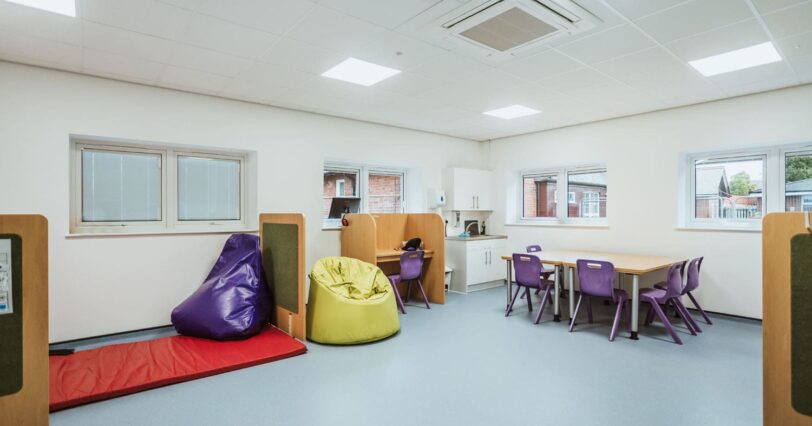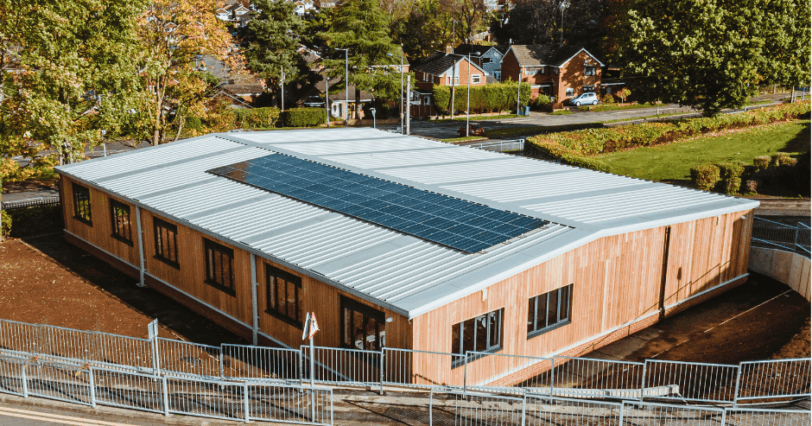As the education sector faces rising costs, new regulations and environmental challenges, schools around the UK are embracing exciting and innovative trends in sustainable buildings. We sat down to review the biggest influences that are transforming schools.
- VAT policy shifts in independent schools
One of the biggest news items in education over the last year is the removal of the VAT exemption for private schools, which could drive up tuition fees by 20% and impact budgets for infrastructure upgrades. As a result, it’s likely that state schools will see a sharp increase in enrollments, with over 3,000 new students applying for a space at state schools already.
For state schools themselves, this could mean an urgent need to expand capacity, adapt facilities and prepare for higher student numbers. Proactive planning and the exploration of sustainable and flexible building solutions is key for schools likely to see an influx.
2. Sustainable technology and biophilic design
As part of the UKs commitment to achieving net zero emissions, the government is stepping in to help schools make energy-efficient improvements. Grants for sustainable upgrades, like better insulation, LED lighting and solar panel installations are helping schools across the UK reduce their energy footprint and operational costs. Schools have been making immediate, high-impact changes and are reaping the benefits of green savings in a time of fluctuating energy prices.
At the same time, schools are also integrating natural elements, think green walls, wide windows and outdoor classrooms, into their school design. Known as ‘biophilic design’, this approach not only supports student wellness but also aligns with recent health standards from the Department for Education (DfE), which prioritises improved air quality in learning environments. Schools are also adding advanced HVAC systems and CO2 monitors to promote healthier, more vibrant indoor spaces that foster academic engagement.
- Climate resilience with water efficiency and adaptable infrastructure
Schools in the UK are preparing for the challenges of climate change with water conservation strategies like rainwater harvesting and smart irrigation systems. In areas at risk of flooding, many schools are incorporating permeable paving, raised foundations and rain gardens to mitigate the effects of increased rainfall. These measures aim to conserve resources, safeguard school facilities and minimise future disruption, ultimately ensuring that schools are ready to face the changing climate.
- Tackling Scope 3 emissions in school building projects
As part of the broader push to meet net zero targets, UK schools are starting to turn their attention to Scope 3 emissions, which account for indirect emissions across the value chain, such as building materials, transportation and waste management. By choosing sustainable materials, reducing waste and optimising supply chains, schools can significantly lower their environmental impact.
At Net Zero Buildings, our factories create zero waste to landfill and we only work with sustainable supply chain partners to reduce the Scope 3 emissions in all of our projects.
- Childcare expansion and wraparound care schemes
A major trend that has reshaped schools is the introduction of expanded childcare to support working parents.
Childcare expansion saw parents of two-year-olds able to access 15 hours of government funded childcare. This was extended to 15 hours of childcare to all children from the age of nine months from September and is set to expand from September 2025 to give working parents of children under five to 30 hours of government-funded childcare per week. School based nurseries are central to this initiative, helping parents to get back to work, provide early intervention for SEND children and narrow achievement gaps in disadvantaged areas.
This trend is expected to extend over the next couple of years, as by 2026, all parents and carers of primary school-aged children will have access to breakfast and after school clubs, creating wraparound care from 8am to 6pm.
What’s next for 2025?
With the UK government requiring all public sector buildings, including schools, to implement climate action plans this year, it’s time to start preparing. This means assessing current energy usage, setting measurable sustainability targets, and planning for energy-efficient upgrades.
Schools should prioritise investments in renewable energy systems and begin to transition to low carbon heating solutions and will need to engage with contractors and suppliers who can use sustainable materials to support their goals. Early preparation is key to meeting these requirements on time and ensuring long-term sustainability.
Ready to future proof your school’s sustainability? Get in touch with one of our experts today.







